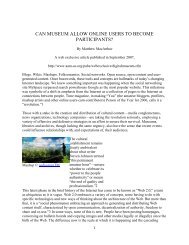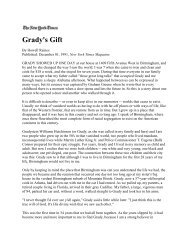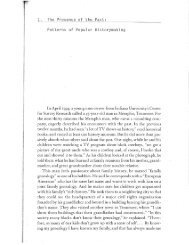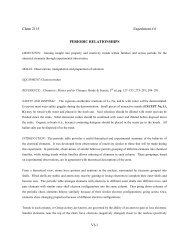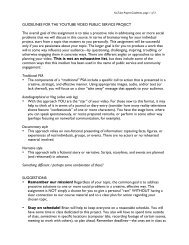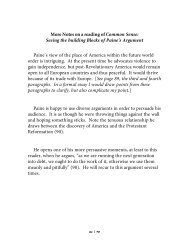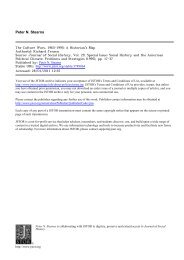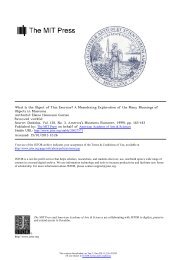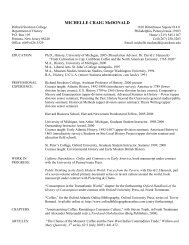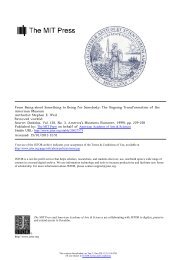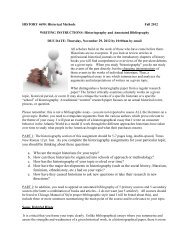Domesticating Barbie - Richard Stockton College Word Press ...
Domesticating Barbie - Richard Stockton College Word Press ...
Domesticating Barbie - Richard Stockton College Word Press ...
You also want an ePaper? Increase the reach of your titles
YUMPU automatically turns print PDFs into web optimized ePapers that Google loves.
250 Pearson and Mullins<br />
<strong>Barbie</strong>'s redomestication. The politics of Mattel itself are zealously guarded (or<br />
denied altogether), but <strong>Barbie</strong>'s 1980s embrace of cooking, cleaning, and compa<br />
rable domestic tasks suggests their conservative corporate vision of femininity. At<br />
the very least, many <strong>Barbie</strong> consumers and Mattel are wary of being labeled femi<br />
nist: they do not see themselves radically transforming society's bedrock structure<br />
as much as they are celebrating a universe of preexisting women's aspirations and<br />
timeless "feminine" attributes (cf. Lord, 1994, pp. 90-91).<br />
In addition to her expanded household labor tasks, <strong>Barbie</strong> now cares for her<br />
Baby Sister Kelly as part of her domestic chores. Kelly comes with <strong>Barbie</strong> in<br />
"Stroller Fun <strong>Barbie</strong> and Kelly," "Shoppin' Fun <strong>Barbie</strong> and Kelly," and "Birthday<br />
Party <strong>Barbie</strong> and Kelly." Kelly also can be purchased separately as "Bathtime Fun,"<br />
"Bedtime Fun," and "Potty Training Kelly," in which "You and <strong>Barbie</strong> feed Kelly<br />
her bottle, then put her on her potty. Squeeze her tummy and she really tinkles!...<br />
Uh oh! When accidents happen, diaper bag opens into a mat and you can change<br />
Kelly doll's wet diaper!" In keeping with the traditional vision of domesticity as<br />
motherhood or<br />
personal nurturing, Kelly's childcare labor is presented as endless<br />
satisfaction if not "fun," as the playset names emphasize. The exception is "Potty<br />
Training Kelly": apparently even Mattel drew the line at calling toddler's toilet<br />
instruction "fun." There is no hint that <strong>Barbie</strong> receives even an allowance for<br />
this labor, instead seeking what Elizabeth Fox-Genovese (1991, p. 124) calls "the<br />
selfless gratification of nurture."<br />
In the early 1980s Mattel shifted its <strong>Barbie</strong> production and sales strategy, mar<br />
keting dolls for play focused on particular activities, such as hair style, recreation,<br />
and glamour (Lord, 1994, p. 112). Different dolls were sold with functionally<br />
distinct clothing and accessories which targeted certain girls's activities in the<br />
hope that consumers would purchase multiple dolls for different sorts of function<br />
ally focused role play. The 1982 "Magic Curl <strong>Barbie</strong>," for instance, had densely<br />
curled hair which girls were expected to wash and style, providing a sharply fo<br />
cused play activity (Westenhauser, 1994, p. 112). Similarly, "Rocker <strong>Barbie</strong>" was<br />
among a series of 1984-1985 "Rocker" dolls dressed in new-wave dance fashions<br />
and accompanied by cassettes with original songs (Summers, 1997, pp. 79-82).<br />
Instead of owning one or two dolls alongside a large assemblage of clothing and<br />
accessories, Mattel hoped that consumers would purchase numerous functionally<br />
distinct, stylistically individual dolls. This strategy to increase doll consumption<br />
apparently has been utterly triumphant: Mattel believes that over 95% of American<br />
girls between 3 and 11 years of age own at least one <strong>Barbie</strong>, and the average num<br />
ber of <strong>Barbie</strong>s in any assemblage is seven or<br />
eight (Chamberlain, 1995, p. 57;<br />
Shapiro, 1992). In the midst of this marketing shift, Mattel fought through<br />
a series<br />
of economic setbacks which could be erased only by <strong>Barbie</strong> sales, increasing the<br />
doll's already monumental importance to the company. In 1996, <strong>Barbie</strong> accounted<br />
for $1.7 billion in sales, nearly 40% of Mattel's total revenues of $4.5 billion<br />
(Morgenson, 1997, p. 46).<br />
This content downloaded on Tue, 15 Jan 2013 10:45:42 AM<br />
All use subject to JSTOR Terms and Conditions



